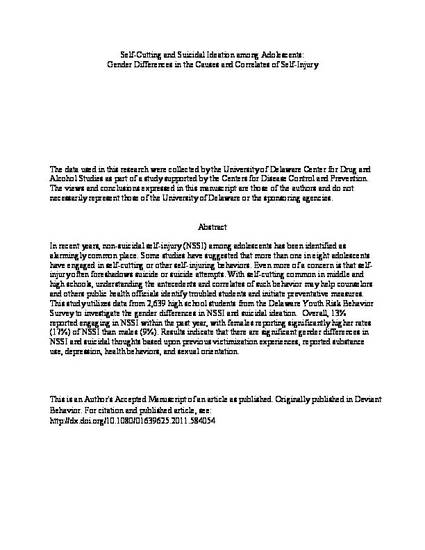
Article
Self-Cutting and Suicidal Ideation among Adolescents: Gender Differences in the Causes and Correlates of Self-Injury
Deviant Behavior
(2012)
Abstract
In recent years, non-suicidal self-injury (NSSI) among adolescents has been identified as alarmingly common place. Some studies have suggested that more than one in eight adolescents have engaged in self-cutting or other self-injuring behaviors. Even more of a concern is that self-injury often foreshadows suicide or suicide attempts. With self-cutting common in middle and high schools, understanding the antecedents and correlates of such behavior may help counselors and others public health officials identify troubled students and initiate preventative measures. This study utilizes data from 2,639 high school students from the Delaware Youth Risk Behavior Survey to investigate the gender differences in NSSI and suicidal ideation. Overall, 13% reported engaging in NSSI within the past year, with females reporting significantly higher rates (17%) of NSSI than males (9%). Results indicate that there are significant gender differences in NSSI and suicidal thoughts based upon previous victimization experiences, reported substance use, depression, health behaviors, and sexual orientation.
Keywords
- Substance Use,
- Self-Injury,
- Gender,
- Suicide
Disciplines
Publication Date
2012
DOI
10.1080/01639625.2011.584054
Citation Information
Bakken, Nicholas W. and Whitney DeCamp. (2012). Self-Cutting and Suicidal Ideation among Adolescents: Gender Differences in the Causes and Correlates of Self-Injury. Deviant Behavior, 33, 339-356. doi:10.1080/01639625.2011.584054
